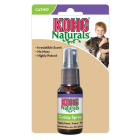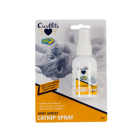
Catnip Genus: Nepeta
Catnip Family: Lamiaceae
Botanical name: Nepeta catara
What is catnip?
From the mint family, Catnip is a perennial herb. Its square, hairy stalk and typically green/grey colored heart-shaped leaves with scalloped edges that are quite distinctive. Catnip flowers grow in spikes, reaching about 1/2 inch in length. It is best known for its reputation: Catnip gets cats high.
There are over 250 species of flowering plants in the Catnip plant family. Catnip was originally native to Europe and Asia but was introduced to North America and Canada in the 1600s. The name Nepeta comes from the town of Nepete in Italy, and Cataria comes from the Latin word for cat.
How Does Catnip Effect Cats?
An essential oil called nepetalactone is the active ingredient that causes a high in cats. The Catnip active ingredient is found in the leaves and stems of the plant.
Nepetalactone causes a hallucinogenic effect in cats. The effect of Catnip has been compared to LSD and more often marijuana. Some have suggested that Catnip is an aphrodisiac however veterinarians consider this unlikely. More likely the cat is reacting to similar feel-good pheromones released during sexual courtship/activity.
Are all Cats affected by Catnip?
About half of all cats are affected by catnip. Some more than others. Kittens younger than eight weeks old don't seem to enjoy its effect; in fact, they show an aversion to it. The response to catnip is mediated through the olfactory system. When nepetalactone enters the cat's nasal passages, it binds to olfactory receptors located at the olfactory epithelium. This stimulates sensory neurons, which trigger neurons in the olfactory bulb to send signals to the brain. The response to catnip is inherited as an autosomal dominant gene, which means the gene only needs to be passed on from one parent.
How do Cats Behave After Eating Catnip?
Many cats respond to catnip by sniffing, chewing, licking, head shaking, and chin, cheek, and body rubbing. Additional responses may include stretching, drooling, jumping, licking, aggression, and hyperactivity.
How do Cats Enjoy Catnip?
It is believed that cats eat catnip to bruise the catnip, thereby releasing more of the nepetalactone that they ingest nasally. The high produced will usually last between five and ten minutes.
Can Catnip Hurt My Cat?
Catnip is not harmful to your cat. They won't overdose on it. Most cats know when they've had enough and will refuse any further offers.
How do I Give Catnip to My Cat?
- There are a number of ways to give catnip to your cat:
- You can grow it in a pot and keep it near a window or in their cat enclosure. They can have a nibble as they see fit.
- You can dry it out and sprinkle some on the floor for them.
- You can buy toys with catnip in them. Most pet shops sell toy mice filled with catnip.
How much catnip should I give my cat?
If you are giving him dry catnip, a couple of small pinches will do.
How do I Grow Catnip?
Catnip is fairly easy to grow. You can purchase the catnip plant from your local garden center. You can also grow catnip from seed, but the germination rate can be quite low. Catnip likes light, sandy soil and grows best in full sun. Make sure you keep it well-watered until it has become established.
As the plant is growing, pinch out the top growth tips to promote leaves. If you are planting it in a garden your cat has access to, make sure there is plenty of adjacent space around the plant so that other plants won’t be damaged if your cat rolls in it. If you have catnip in a pot for an indoor cat, have several pots growing outdoors so that you can rotate plants regularly.
Does catnip work on humans?
Catnip doesn't induce a high in humans as it can in cats. If anything it tends to have a sedative effect, instead. While it is harmless to humans, pregnant women should still avoid catnip as there isn't enough research to completely rule out any complications.


